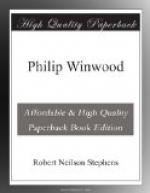Before the Revolution, there were Queen Street and Pearl Street, together forming a line continuous though not exactly straight. After the Revolution, the whole line was named Pearl Street. King Street and Duke Street were others that rightly underwent re-christening. But, with equal propriety, many old names smacking of the English regime were retained, and serve as memorials of the English part of the city’s colonial history: such names, for instance, as William Street, Nassau Street, Hanover Square, Kingsbridge; not to mention New York itself. The old Dutch rule, too, remains marked in the city’s nomenclature—for ever, let us hope. I say, “let us hope;” for there have been attempts to have the authorities change the name of the Bowery itself, that renowned thoroughfare which began, in the very morn of the city’s history, as a lane leading to Peter Stuyvesant’s bauer. I scarce think this desecration shall ever come to pass: yet in such matters one may not be sure of a nation which has permitted the spoiling (by the mutilation of headlands and cliffs, for private gain) of a river the most storied in our own land, and the most beautiful in the world.
NOTE 2 (Page 34).
In 1595 was published in London: “Vincentio Saviolo his Practise. In two Bookes. The first intreating the use of the Rapier and Dagger. The second of Honour and Honourable Quarrels.” (Etc.) The celebrated swordsman sets forth only the Italian system, and has naught to say upon the French. The book that Winwood studied may have been some reprint (now unknown), with notes or additions by a later hand. In any case, he may have acquired through it sufficient rudimentary acquaintance with some sort of practice to enable him to excite the French fencing-master’s interest.
NOTE 3 (Page 182).
“Lady Washington’s Light Horse” was a name sometimes unofficially applied to Lieut.-Col. Baylor’s Dragoons. They were sleeping in a barn and outbuildings, at Old Tappan, one night in the Fall of 1778, when they were surprised by General Grey, whose men, attacking with bayonets, killed 11, mangled 25, and took about 40 prisoners. Both Col. Baylor and Major Clough were wounded, the latter fatally. It is of course this affair, to which Lieut. Russell’s narrative alludes.
NOTE 4 (Page 191).
The Morris house, now known as the Jumel mansion, was half a generation old at the beginning of the Revolution. Thither, as the bride of Captain Morris, a brother-officer of Washington’s in the old French war, went Mary Philipse; whom young Washington was said to have wooed while he tarried in and about New York upon his memorable journey to Boston to solicit in vain, of Governor Shirley, a king’s commission. The Revolution found the Morrises on the side opposed to Washington’s; for a short time during the operations above New York in 1776 he occupied this house of theirs as headquarters. They lost it through their allegiance to the royal




